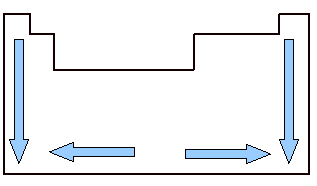The dry air has about 78% nitrogen gas (N2), 21% oxygen gas (O2) and 1% of other gases, in volume. This means that we have a ratio of 1: 4: 5 of oxygen gas, nitrogen gas and total air, respectively.
Air participates in many reactions, especially oxidation reactions such as combustion. In reality, however, the only component of air that reacts is oxygen, with nitrogen being considered inert. But, although it does not participate in the reaction, nitrogen is part of the reacting air and the final gases produced.
Thus, when a reaction takes place with the participation of air, it may be necessary to find factors such as: what is the mass of oxygen that reacted, what is the volume of air, what is the volume of the final reaction gases, how much nitrogen was present in the air and in the final gases and so on against.
See the example below and look at two ways that can be used to perform these calculations. One way is using the rule of three and the other is using the quoted stoichiometric ratio ( 1 (oxygen) : 4 (nitrogen) : 5 (air)):
Example:
Assume that a volume of 40 L of methane (CH4) was completely burned, under ambient conditions of temperature and pressure, producing carbon dioxide (CO2) and water (H2O). Considering an approximate air composition of 80% nitrogen gas (N2) and 20% oxygen gas (O2), answer:
a) What is the volume of oxygen gas consumed in this reaction?
b) What is the volume of air needed for combustion?
c) What is the total volume of gases at the end of the reaction?
Resolution:
a) To perform this calculation, we need to write the chemical equation that represents balanced methane combustion:
CH4 + 2 O2 → CO2 + 2 H2O
1 mol 2 mol 1 mol 2 mol
Considering that the reaction yield was 100%, we have:
1 L of CH4 2 L of O2
40 L of CH4 x
x = 40 L. 2 L
1 L
x = 80 L of O2(g)
80 L of oxygen gas were consumed under these conditions.
b) If the oxygen volume is 80 L, the air volume will be:
20% of O2 100% air
80 L of O2 x
x = 80 L. 100%
20%
x = 400 L of air
Another way to solve this issue was to use the ratio of oxygen gas to air shown at the beginning of the text, which is 1: 5. So, it was enough to multiply the oxygen volume by 5:
80 L. 5 = 400 L of air
c) CH4 + 2 O2 → CO2 + 2 H2O
1 mol 2 mol 1 mol 2 mol
40 L 80 L 40 L 80 L
From the above reaction, we see that 40 L of carbon dioxide and 80 L of water were obtained, which gives a total of 120 L of products. But, there is still the nitrogen gas present in the air that doesn't react. So, we need to find out what its volume is too:
80% of N2 100% air 80% N2 20% of O2
x 400 L of air or x 80 L of air
x = 80 L. 400L x = 80 %. 80L
100% 20%
x = 320 L of N2x = 320 L of N2
This calculation could also have been done more simply, using the 1:4:5 ratio.
1 The2 4 N2 or 5 air 4 N2
80 L x 400 L x
x = 320 Lx = 320 L
Now, just add this value with that of the other gases to know the total volume of gases at the end of the reaction:
120 + 320 = 440L of gases
By Jennifer Fogaça
Graduated in Chemistry
Source: Brazil School - https://brasilescola.uol.com.br/quimica/participacao-ar-nas-reacoes-quimicas.htm

